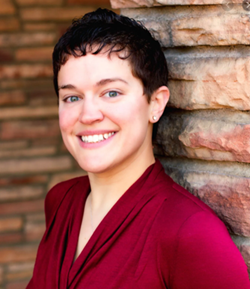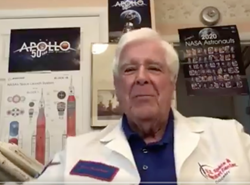September 25th 2020
GeoDirectory were literally over the moon to play host to two incredibly interesting and engaging speakers on our most successful webinar to date. The theme was ‘Space’ and attendees were there to ‘Meet the Rocket Man and the Stargazer”.
Our key Space speakers were award winning American Astronomer and Author, Emily Levesque and former NASA Director of Quality Assurance at Marshall Space Flight Centre, Ron Bledsoe.
Emily Levesque

Within seconds Emily drew the audience in by citing the simple first words of her new book,
The Last Stargazers. “Have you tried turning it off and on again?” are Emily said, “words most of us hear when on hold for technical support”. But for Emily these words were asked of her during one of the most tense evening of her life. She was a 24 year old graduate at Subaru Telescope, Mauna Kea, Hawaii. At the time Emily was using the telescope to study distant galaxies that hosted explosive stars, trying to study their chemistry to understand what had happened to the stars within them and if that explained how they worked.
Access to a telescope is a real privilege and this one was given on a ‘one night only’ basis, an opportunity that would not present itself for at least another 12 months. While working there, with only one other person, Emily heard a very loud beep. This is the moment Emily took the webinar audience through the scale of the telescope and the enormous mirrors used, showing visuals from a similar telescope in Chile. The scale in itself was so impressive and Emily went on to explain that the mirror alone was over 8 metres end to end and suspended approximately 70 feet above the floor of the telescope. It weighed about 400lbs and was held in place by a series of mechanical supports. The noise that she heard was telling her that the supports might have failed and if she moved the mirror at all she was at risk of dumping it on to the floor of the dome, potentially breaking the largest piece of glass in the world! Having called the Engineer in charge of keeping the telescope healthy his response was “have you tried turning it off and on again?”.
This was the first of many entertaining anecdotes from Emily, after which she answered a number of questions from the live audience. In an effort to explain the width of the universe Emily said “that’s a difficult one to answer because our ability to measure it is limited by the speed of light. We know that the universe is about 13.7 billion years old which places a limit on how far we can see. We can see light that was emitted 13.7 billion light years away is just now making it to earth. We know that there is more universe beyond that but measuring how much there is, how it is expanding, how it is evolving and how it is going to end is hard to see. The challenge now is to build telescopes that can see as close to that 13.7 billion light year limit as possible.”
Ron Bledsoe

Ron provided us with a brief career history, stuff most of us only dream of. He then shared video footage and images taking us through the Apollo Programme and the various rocket engines. We saw Saturn Rockets which Ron worked on and which completed 33 successful launches, and learned about their special features. Astonishingly, a Saturn V Vehicle (F1 Engine) pump could remove all the water from an Olympic swimming pool in just a few seconds!
Ron also talked through the very gruelling work schedule that occurred around a launch, often leaving home one morning not to return from work until the following morning, or even a couple of days later. But he admitted it was a labour of love for all of them and he talked about the very talented and skilled people he worked with, and the rigorous training procedures they all went through.
But the hot topic of the day was largely a result of Netflix’s very popular docuseries, Challenger: The Final Flight. Ron was at NASA during the Challenger period with responsibility for the three engines that flew on the shuttle, all with 500 to 1,000lb thrust. He and his team were trained to put emotions to the side and immediately looked at data from everywhere such as engines and external tanks etc. to work the problem and find the cause and solution. Immediately after the Challenger disaster, Ron was promoted to Chief of Quality Assurance and they have not had a fatality since.
After his presentation, Ron also stayed online to take part in a lively Q & A session and when asked what was harder to work on, the Apollo or the Space Shuttle missions, he couldn’t decide saying “I was very fortunate to work on both. I can’t judge which one was harder because I loved working on both of them, it was exciting for me”.
Feedback from the event was really positive. Here’s a sample of what was said:
“Congrats for the webinar. It was fantastic! I really enjoyed it, especially the first part with Emily Levesque as I'm into stargazing and photography myself, so I was really curious about her speech which I really enjoyed. Thanks!”
“I just wanted to say sincere thanks for the invite to your webinar last Thursday. It was really fascinating – such a brilliant combination of speakers, both captivating. In a time of so much bad news, it was lovely to experience some magic. I really felt like I had been transported to another world with Ron – what an incredible life story!”
“Thanks again – yet again you raise the bar!!”
“Well done on the webinar earlier. Emily’s enthusiasm about her field was extremely infectious and what a privilege to hear someone like Ron speak about his incredible experiences! Thanks so much, I really enjoyed it.”
To view this brilliant webinar click here.